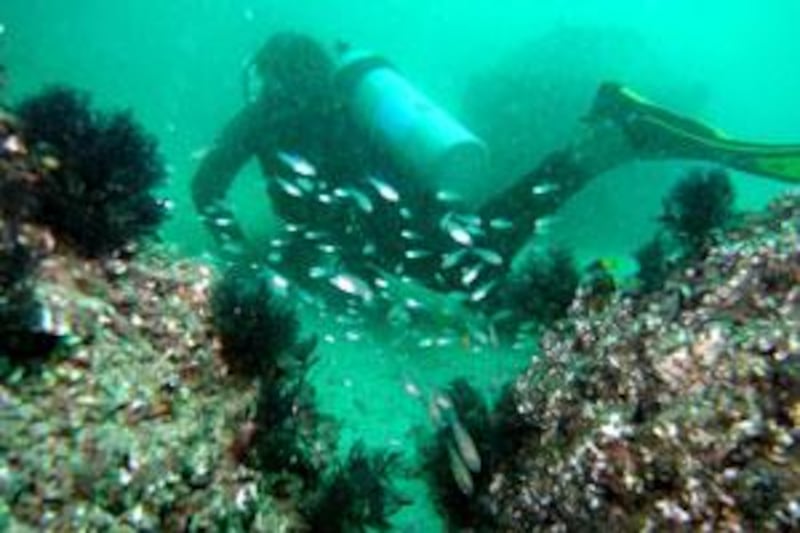FUJAIRAH// Eight months after it was launched, a plan to use artificial materials to rehabilitate coral reefs 100 metres off the coast of Dibba seems to be encouraging sea life. In June, 15 large reef balls - dome-shaped, concrete spheres with holes in the sides and top, some weighing more than two tonnes - were placed in the water in front of Le Méridien Al Aqah Hotel. An additional 20 have been placed since, and an exploratory dive this week revealed that a variety of young and adult fish have made the reefs their home.
The structures are also covered in barnacles and what is believed to be the beginnings of soft coral. Although marine biologists have not confirmed the findings, divers who have been conducting monthly monitoring of the site were confident there had been significant progress. "We've been monitoring the progress of the reef closely since we laid the first blocks," said Simon Tambling, the managing partner of Al Boom divers, which oversees the practical arm of the project.
The goal is to have soft corals form in five years, followed by hard versions in the long-term. So far the project has cost Dh100,000 (US$27,000) for the materials and manpower required to place the original reef balls. They are made of a specially formulated pH-neutral concrete and gravel mix which does not change the water's acidity. They are placed under the water using a combination of cranes and parachutes.
Artificial reef balls are used worldwide to aid the recovery of coral reefs. In Abu Dhabi, the results of a three-year study by the Emirates Wildlife Society - World Wide Fund for Nature and the Environment Agency-Abu Dhabi (EAD) released last year said that 65 per cent of Abu Dhabi's corals was already lost, due to natural and man-made causes. Reefs were also at a record low. Ashraf al Cibahy, the manager of marine-protected areas for the EAD, said the balls could help, but should also not be relied upon.
"There are pros and cons for everything when you interfere with environment. The artificial reefs are tools for supporting and enhancing the marine environment but should only be used as a last resort," he said. "It is obviously better to preserve the environment before damaging it." Creating protected areas for marine conservation was the best way to do this, he said. Patrick Antaki, the general manager of Le Méridien Al Aqah, which is also involved in the project, said the artificial reef was meant to help restore damage done by a cyclone that hit the coast in January 2008.
"The beach was completely reshaped by the force of the hurricane, and large parts of the reef were severely damaged," he said. "We took advice from dive societies and marine biologists and decided the right thing to do was the artificial reef project. We wanted to be responsible for the environment that directly surrounds us," he said. The location for the artificial reef was thoroughly researched, said Samantha Joffe, business developer from Al Boom Divers. It was placed along the line of the currents between two reefs
"We chose an area with plenty of nutrition-filled water flowing through it, as well as one which would provide shelter for younger fish," said Ms Joffe. "There are already plenty of juvenile banner fish, hammour, puffer fish and jacks using it as their home. This is a great sign and is encouraging for the future." aseaman@thenational.ae





